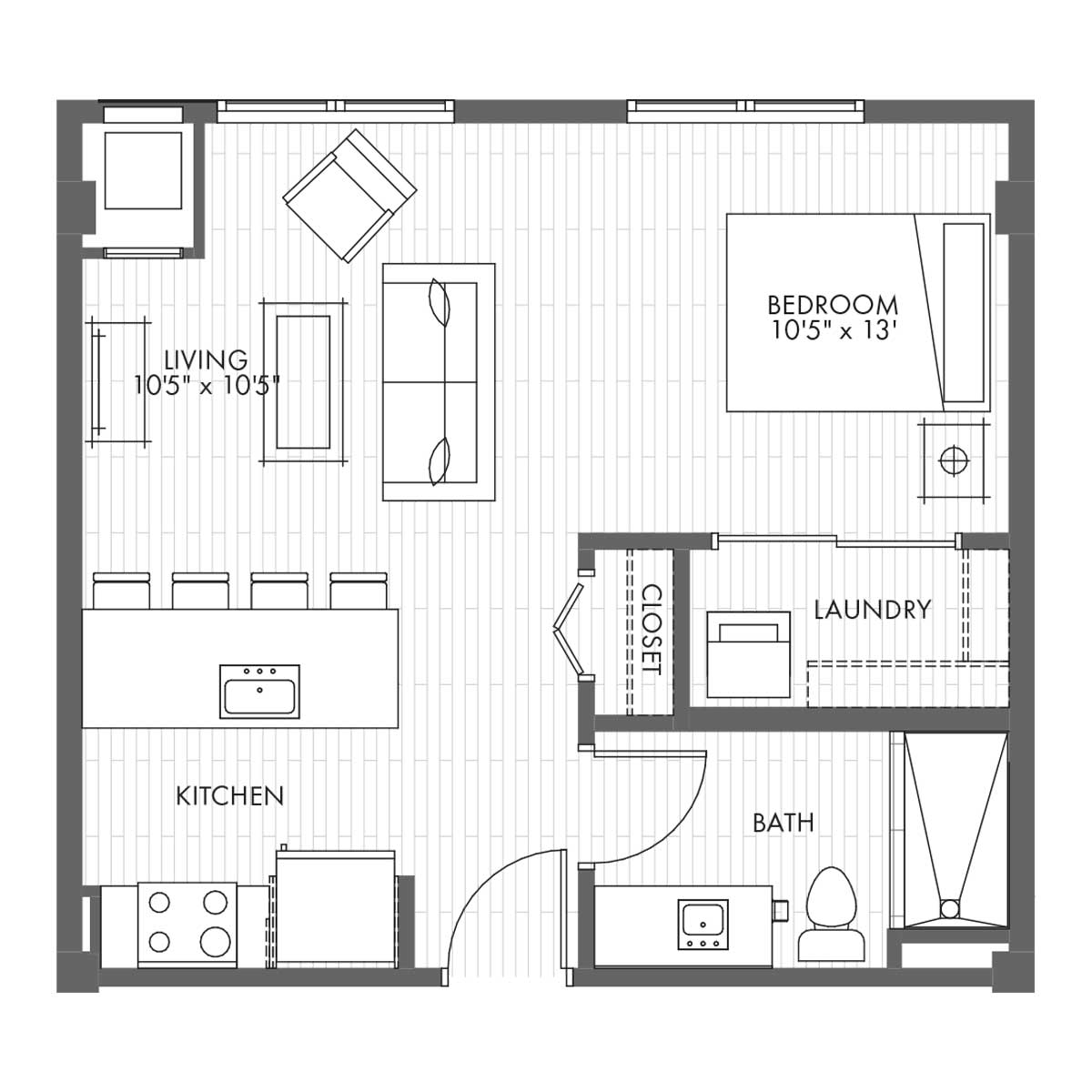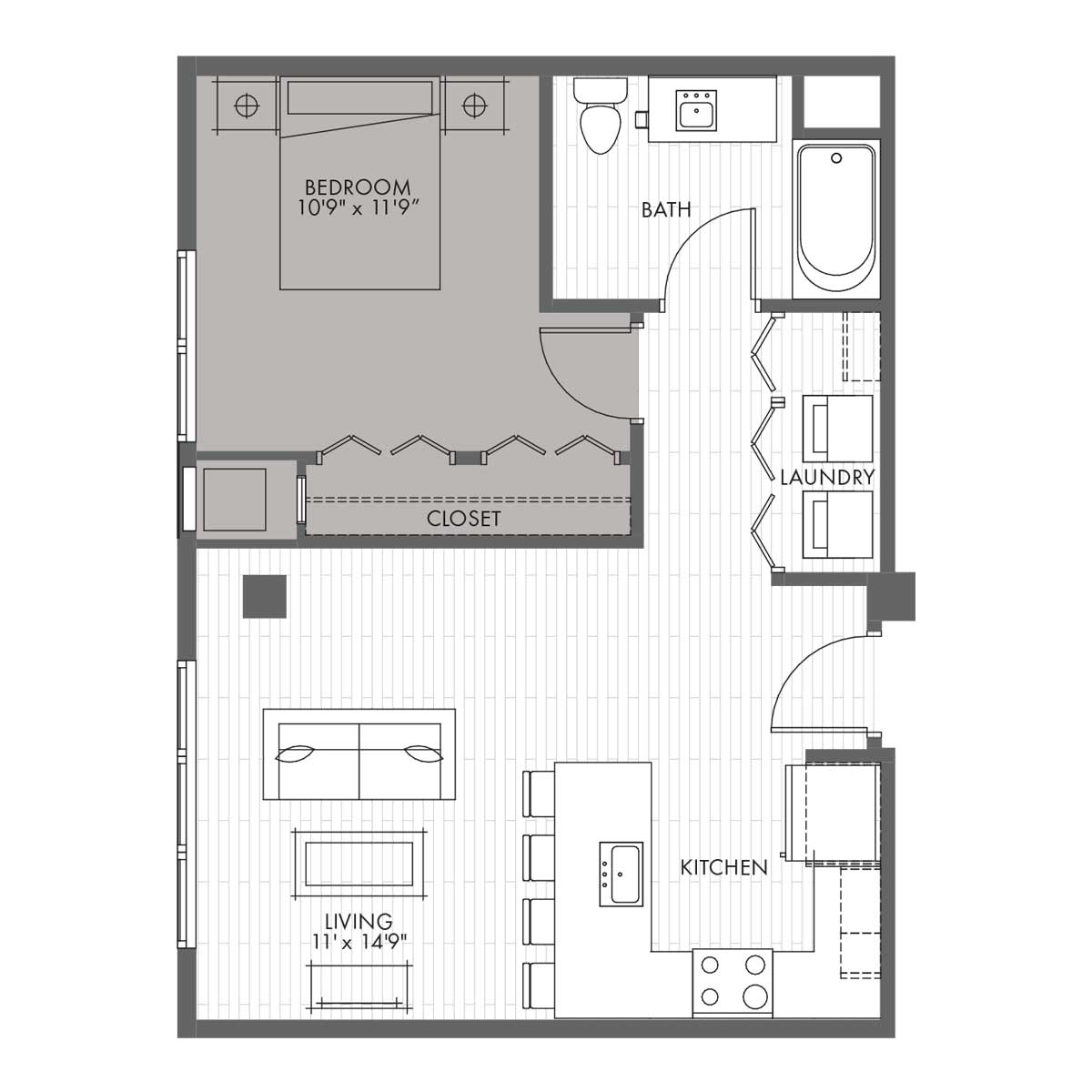Maximizing Space in Small One-Bedroom Apartments: Floor Plans For Small One Bedroom Apartments

Living in a small one-bedroom apartment can be a delightful challenge. It’s a space where creativity meets functionality, demanding you to think outside the box and make every inch count. But fear not, because with the right strategies, you can transform your compact abode into a haven of comfort and style.
Furniture Arrangement, Floor plans for small one bedroom apartments
Strategic furniture placement is paramount in small spaces. It can make or break the flow and functionality of your apartment. The key is to choose furniture that serves multiple purposes and optimize its arrangement to maximize space.
- Opt for furniture with built-in storage, such as a bed frame with drawers, a coffee table with shelves, or a sofa with hidden compartments. These pieces not only provide seating or sleeping space but also offer valuable storage, minimizing clutter and maximizing space.
- Employ multi-functional furniture, like a sofa bed or a dining table that converts into a desk. These pieces can easily transition between different uses, making the most of your limited floor space.
- Use the walls to your advantage. Install wall-mounted shelves, mirrors, or a floating desk to create visual space and free up floor area.
Storage Solutions
Storage solutions are essential in small apartments. They help to keep your belongings organized and out of sight, creating a sense of spaciousness.
- Utilize vertical space by incorporating tall bookshelves, cabinets, or even a ladder-style shelving system. This maximizes storage capacity without taking up valuable floor space.
- Consider under-bed storage bins or drawers. These provide hidden storage for items you don’t need daily, freeing up closet space and keeping your floor clear.
- Invest in a storage ottoman or a bench with built-in storage. These pieces offer additional seating while providing concealed storage for blankets, pillows, or other items.
Multi-Functional Design Elements
Multi-functional design elements are essential for small apartments, allowing you to maximize space and create a sense of flow.
- Incorporate a room divider to create a visual separation between different areas within your apartment. This can be a bookshelf, a curtain, or even a free-standing screen, allowing you to define different zones without sacrificing space.
- Utilize mirrors strategically to create an illusion of space. Mirrors reflect light and make a room appear larger. Place them opposite windows or on a wall to maximize the effect.
- Choose light and airy colors for your walls and furniture. Lighter colors reflect more light, making a room feel brighter and more spacious.
Popular Floor Plan Configurations for Small One-Bedroom Apartments

Choosing the right floor plan for a small one-bedroom apartment can be a daunting task. There are many configurations to consider, each with its own unique advantages and disadvantages.
This section explores popular floor plan configurations for small one-bedroom apartments, providing insights into their functionality, flow, and aesthetics. By understanding the nuances of each configuration, you can select the perfect layout for your needs and preferences.
Open-Concept Layouts
Open-concept layouts are becoming increasingly popular in small apartments due to their ability to maximize space and create a sense of openness. In this configuration, the living room, dining area, and kitchen are seamlessly integrated, eliminating walls and creating a unified space.
- Pros: Open-concept layouts create a sense of spaciousness, allowing natural light to flow freely throughout the apartment. They also promote a feeling of connectedness and encourage interaction between different areas of the apartment.
- Cons: Open-concept layouts can make it challenging to create distinct zones for different activities, especially if you enjoy privacy or prefer separate spaces for work, dining, and relaxation. The lack of walls can also lead to noise carrying throughout the apartment, potentially affecting your peace and quiet.
Studio Apartments
Studio apartments offer a compact and efficient living experience. They typically combine the living room, bedroom, and kitchen into a single space, eliminating the need for separate rooms.
- Pros: Studio apartments are ideal for single individuals or couples who value affordability and a minimalist lifestyle. Their compact design minimizes cleaning and maintenance, making them perfect for those who prefer a streamlined living experience.
- Cons: Studio apartments can feel cramped and lack privacy, especially if you enjoy having distinct areas for different activities. The lack of separation between the living and sleeping areas can also make it challenging to create a relaxing and conducive sleep environment.
Traditional Layouts
Traditional layouts for one-bedroom apartments feature separate rooms for the living room, bedroom, and kitchen. This configuration provides distinct spaces for different activities, offering greater privacy and functionality.
- Pros: Traditional layouts offer a sense of privacy and separation between different areas of the apartment. They also allow for dedicated spaces for specific activities, such as work, dining, or relaxation. This can be particularly beneficial for individuals who prefer a more structured living environment.
- Cons: Traditional layouts can feel more confined and less spacious compared to open-concept layouts. They may also require more furniture to define separate areas, which can make the apartment feel cluttered if not carefully planned.
Design Considerations for Small One-Bedroom Apartments

Living in a small one-bedroom apartment doesn’t mean you have to sacrifice style or comfort. A little creativity and careful planning can transform your compact space into a haven of light, airy, and functional living.
Maximizing Natural Light
Natural light is a powerful tool in making a small space feel larger and more inviting. It can brighten up a room, create a sense of spaciousness, and even enhance your mood.
- Light-Colored Paint: Painting your walls in light colors like white, cream, or pale pastels can reflect light and make the space appear larger. A light and airy color palette can also create a sense of calm and serenity.
- Maximize Window Sizes: If possible, maximize the size of your windows to let in as much natural light as possible. Consider replacing small windows with larger ones or adding a bay window to enhance the flow of light.
- Incorporate Mirrors: Mirrors strategically placed around the room can reflect light and create the illusion of more space. A large mirror opposite a window can amplify natural light and create a sense of depth.
Utilizing Ventilation
Good ventilation is crucial for a healthy and comfortable living environment, especially in a small apartment. It helps to circulate fresh air, reduce humidity, and prevent the build-up of odors.
- Open Windows: Open windows whenever possible to allow fresh air to circulate. This is particularly important after cooking or cleaning.
- Use Fans: Ceiling fans and portable fans can help circulate air and create a refreshing breeze, especially during hot weather.
- Consider an Exhaust Fan: Installing an exhaust fan in the bathroom and kitchen can help remove moisture and odors.
Creating a Welcoming Color Palette
The right color palette can set the tone for your entire apartment. Choose colors that create a sense of calm, spaciousness, and warmth.
- Light and Neutral Colors: Light colors, such as white, cream, and pale gray, can make a small space feel larger and more airy. They can also reflect light and create a sense of brightness.
- Accent Colors: Use accent colors to add pops of personality and visual interest. Consider incorporating bright colors like blue, green, or yellow in your furniture, artwork, or accessories.
Floor plans for small one bedroom apartments – Floor plans for small one-bedroom apartments often present a challenge in maximizing space, particularly when considering furniture choices. A well-designed bedroom set, like the tiffany 4 pc queen bedroom set , can be a valuable asset, offering both storage and aesthetic appeal while remaining compact.
This, in turn, allows for a more efficient utilization of the available floor space in the bedroom, creating a sense of openness and functionality.
While floor plans for small one-bedroom apartments prioritize functionality and space optimization, larger residences often explore more elaborate layouts. This is particularly true for master bedrooms, where couples often seek to incorporate separate areas for individual needs and preferences. His and her master bedroom floor plans can include features like dual closets, vanity areas, and even separate sleeping zones, offering a unique blend of privacy and shared space.
These design considerations, while not always feasible in compact living spaces, highlight the diverse approaches to spatial planning within the realm of residential architecture.
